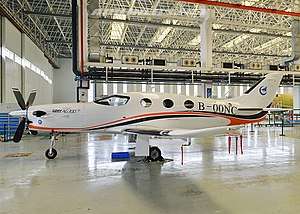CAIGA Primus 150
The AVIC Leadair AG300, previously called Primus 150, built by the China Aviation Industry General Aircraft, is a development of the Epic LT aircraft built using the international rights to Epic Aircraft bought in bankruptcy in 2010. As part of the settlement, Epic retained its rights for American construction and support of its aircraft, creating two divergent lines.[2][3]
| Leadair AG300 | |
|---|---|
 | |
| An AVIC Leadair AG300 at Zhuhai Jinwan Airport. | |
| Role | Single engine turboprop |
| National origin | China |
| Manufacturer | China Aviation Industry General Aircraft |
| First flight | 5 July 2014 |
| Status | In Development |
| Unit cost |
US$1.5 million (outdated)[1] |
| Developed from | Epic LT |
Design and development
China Aviation Industry General Aircraft (CAIGA) begun the process of developing the Epic LT into the Primus 150 for commercial construction, with program first started in November 2011.[4] Maiden flight was successfully completed on July 5, 2014, and Chinese state certification was received in the following year.[4] Three enterprises has signed letter of intend to purchase the aircraft with the unit price of two million US dollars, under the new name Leadair AG300. The general designer is Mr. Xiong Xianpeng (熊贤鹏). Currently, Leadair AG300 is the fastest flying single-engine, propeller driven general aviation aircraft in China.[4] The aircraft is a five-seat low-wing tricycle-gear pressurized turboprop.[5]
Specifications (Primus 150)
Data from Aviation Week[1]
General characteristics
- Capacity: five-seat
- Powerplant: 1 × General Electric H85 Turboprop, 630 kW (850 hp)
- Propellers: four-bladed
Performance
- Cruise speed: 600 km/h (373 mph, 324 kn)
- Range: 2,500 km (1,550 mi, 1,350 nmi)
See also
Related development
Aircraft of comparable role, configuration and era
- Aero Ae 270 Ibis
- Cessna Denali
- Myasishchev M-101T
- Pilatus PC-12
- Piper Meridian
- Socata TBM
References
- Paul Jackson (Oct 8, 2017). "Emerging Aircraft: Props And Turboprops". Aviation Week Network.
- Aviation Week & Space Technology: 68. 14 October 2010. Missing or empty
|title=(help) - Taylor, Ellis (14 November 2014). "AIRSHOW CHINA: CAIGA unveils first indigenous business aircraft". Flightglobal. Zhuhai: Flight International. Retrieved 24 October 2013.
- "Leadair AG300". Retrieved July 6, 2014.
- "CAIGA Selects GE's H85 Turboprop Engine on Primus 150" (Press release). Zhuhai: GE Aviation. 12 November 2012. Retrieved 24 October 2013.